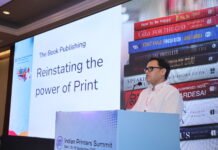New Straits Times Press (NSTP), a Malaysian conglomerate of publishing companies owned by Media Prima, is transforming its footprint on digital platforms. NSTP has redefined its vision and mission to become a leading digital publisher in Malaysia and is now making efforts to become the most preferred digital platform for news and content.
Datuk Abdul Hamid Jalil, managing director, Media Prima believes that digital platforms have a highly volatile and impatient audience. Thus, a fixed set of parameters cannot sustain for long. He believes in failure, learning and improvization through experimenting to gauge what interests the audience. Speaking at the Digital Media India Conference held in Mumbai between 7 and 9 February 2018, Jalil shared Prima Media’s digital journey of many ups and downs. “We went digital in the year 1997, with the launch of our websites. In 2012, we entered the ePaper segment, following which we received great response from our digital readers and subscribers. Considering this, we launched Augmented Reality (AR) features that were one of the latest technological developments in 2013. However, it didn’t take off well with people as there was less awareness on how to use AR via smartphones. AR may have worked well today,” he said.
After this initial setback, NSTP decided to explore other options like social media, eMagazines news stands and education portals. While news stands and eMagazines didn’t work well, social media added a boost to NSTP’s confidence. Later, owing to the data available on Google, the company launched its apps that gained much popularity with its audience.
Restructuring
Sharing details on the restructuring, Jalil said, “We restructured our set-up to meet our target to hit digital platforms as well as to initiate freemium content. The NSTP had three separate newsrooms for each of the products which were merged into one. We started doing this by integrating our sports desk of online and offline operations for the South Asian Games held in Malaysia in 2017.” This integration proved to be beneficial in generating content on both digital and print medium. Both the platforms were able to produce more analytical articles. For optimizing the resources that it had, NSTP also trained its reporters and others on social media on how to use digital platforms more efficiently.
Based on the success of the sports desk, NSTP decided to opt for the restructuring of all its departments. All the departments were provided six months’ training on various aspects and tools on digital platforms for engagement. NSTP’s reporter’s assignment board, which was until then available only with the editors, was shared with everyone that gave access to the reporters and everyone in the organization to know who is doing what. This marked the change in process, making it faster and quick.
The restructure also included reshuffles. Many women reporters from the pool were moved to lifestyle section. This was undertaken by an evaluation conducted on the NSTP’s various websites and apps. The evaluation brought some insights like women preferred reading more lifestyle content. Based on this evaluation and the fact that Malaysian women are predominantly Muslim, the company’s lifestyle newsroom came up with a special feature on ‘How to dress well.’ This feature instantly gained traction with the Muslim women in the city. Jalil said, “This new feature for women was introduced when we found that people are really interested to read such articles. The numbers on the digital platforms helped us to design our features accordingly. Currently, our newspaper apps carry content which is created based on what people read in the past week.”
The newsroom that was operated via desktop PC is now being operated by smartphones. The reporters operate it through an app-based interface, which has features like video editor, language editor, comments, suggestions and look-up. This enables any reporter to file a story quickly, reducing the time taken for upload. As digital medium is fast and quick, such an app-based operation makes it convenient for everyone to be available all the time and their expertise can be shared on-the-go.
The company’s websites generate an enviable traffic of 9.4 million unique digital visitors per month. In 2017, NSTP had 22.1 million audience reach and is considered one of the largest global media houses in Malaysia. Media Prima’s 59% of digital revenue comes from NSTP, which supports the fact that going digital has helped up the revenue quotient. Media Prima’s other verticles like Radio, Television and Content contribute to 7%, 10% and 10% revenue, respectively. Today, the group operates on 50:50 ratio with regard to offline versus online revenue.
Apart from the digital developments in the last two years at NSTP, the company has also resumed printing for other publications besides handling their distribution and logistics. This has served as a new revenue model for the company. The existing digital setup also helps other publications to know about their digital footprint and NSTP serves as a knowledge arm to these publications Jalil believes that there is a need for collaborative effort that involves sharing knowledge, technology and new developments. This will help shape up the industry well and can also help to excel in this competitive yet volatile digital environment.

















